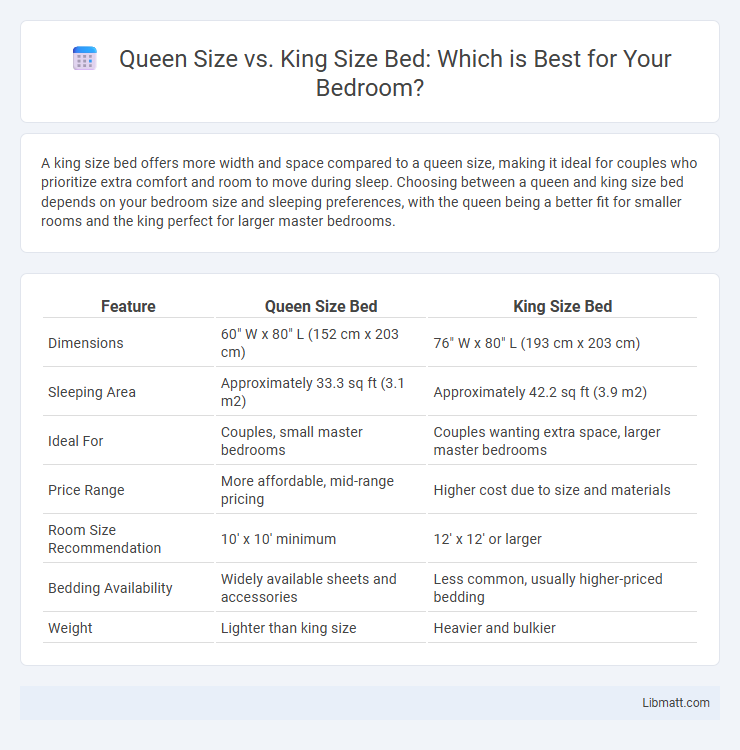A king size bed offers more width and space compared to a queen size, making it ideal for couples who prioritize extra comfort and room to move during sleep. Choosing between a queen and king size bed depends on your bedroom size and sleeping preferences, with the queen being a better fit for smaller rooms and the king perfect for larger master bedrooms.
Table of Comparison
| Feature | Queen Size Bed | King Size Bed |
|---|---|---|
| Dimensions | 60" W x 80" L (152 cm x 203 cm) | 76" W x 80" L (193 cm x 203 cm) |
| Sleeping Area | Approximately 33.3 sq ft (3.1 m2) | Approximately 42.2 sq ft (3.9 m2) |
| Ideal For | Couples, small master bedrooms | Couples wanting extra space, larger master bedrooms |
| Price Range | More affordable, mid-range pricing | Higher cost due to size and materials |
| Room Size Recommendation | 10' x 10' minimum | 12' x 12' or larger |
| Bedding Availability | Widely available sheets and accessories | Less common, usually higher-priced bedding |
| Weight | Lighter than king size | Heavier and bulkier |
Introduction to Queen Size vs King Size Beds
Queen size beds typically measure 60 inches in width and 80 inches in length, offering a spacious sleeping area ideal for couples or individuals who prefer extra room. King size beds measure 76 inches wide by 80 inches long, providing significantly more space and comfort, making them suitable for larger bedrooms and families. Choosing between queen and king size beds depends on bedroom size, sleeping preferences, and budget considerations.
Dimensions: Queen vs King
Queen size beds typically measure 60 inches wide by 80 inches long, providing ample space for couples and fitting well in most bedrooms. King size beds offer a larger sleeping surface, measuring 76 inches wide by 80 inches long, ideal for those wanting extra room or sharing with children or pets. The additional 16 inches in width of a king size bed enhances comfort but requires a more spacious bedroom and larger bedding accessories.
Comfort and Space Considerations
King size beds offer significantly more space, measuring approximately 76 by 80 inches, which provides enhanced comfort for couples or individuals who prefer extra room to move during sleep. Queen size beds, typically 60 by 80 inches, balance comfort and space efficiency, making them ideal for smaller bedrooms or single sleepers desiring more space than a full bed. Choosing your bed size should consider your room dimensions and personal sleep habits to maximize comfort and functionality.
Ideal Room Size for Each Bed
A Queen size bed, measuring 60 by 80 inches, fits ideally in bedrooms of at least 10 by 10 feet to allow adequate space for movement and furniture. King size beds, which measure 76 by 80 inches, require a minimum room size of 12 by 12 feet to maintain comfort and accessibility. Choosing the appropriate room size ensures optimal functionality and enhances bedroom aesthetics for both bed sizes.
Cost Comparison
Queen size beds typically cost between $400 and $1,200, making them a more budget-friendly option compared to king size beds, which range from $700 to over $2,000. The price difference is influenced by mattress dimensions, materials, and brand reputation, with king size beds requiring more raw materials, contributing to higher costs. Consumers should also factor in expenses for accessories like bed frames, sheets, and mattress protectors, which tend to be pricier for king size dimensions.
Bedding and Accessories Differences
Queen size bedding typically includes sheets measuring 60 by 80 inches, while king size bedding expands to 76 by 80 inches, providing extra room to accommodate the larger mattress. Accessories such as comforters, mattress protectors, and bed frames are similarly sized to fit these dimensions, ensuring a proper fit and comfort. Choosing the right bedding and accessories for your bed size enhances sleep quality and overall bedroom aesthetics.
Pros and Cons of Queen Size Beds
Queen size beds offer a balanced option for couples and single sleepers, measuring approximately 60 inches wide by 80 inches long, providing ample space without overwhelming a standard bedroom. Pros include affordability, easier mobility through doorways, and compatibility with a wide range of bedding and accessories. Cons involve limited space for taller individuals or those needing extra room, which might result in less sleeping comfort compared to king size beds.
Pros and Cons of King Size Beds
King size beds offer ample space for couples, enhancing comfort and reducing disturbances during sleep, but they require significantly more bedroom space and can be challenging to move or fit through doorways. They often come with higher costs for mattresses, bedding, and frames compared to queen size beds, which may impact your budget. Choosing a king size bed can improve your sleep quality if space and budget allow, but it's important to weigh these factors carefully.
Choosing the Right Bed for Your Needs
Choosing the right bed size depends on room dimensions and personal comfort preferences, with queen size beds measuring 60 by 80 inches offering ample space for couples while fitting well in smaller bedrooms. King size beds provide a larger sleeping area of 76 by 80 inches, ideal for partners who need extra space or for families sharing the bed with children or pets. Consider lifestyle factors, bedroom layout, and sleeping habits to determine whether a queen or king size bed best meets your comfort and space requirements.
Final Verdict: Queen or King?
Choosing between a queen size and king size bed depends on your room dimensions, sleeping habits, and budget. Queen beds, typically 60 inches wide and 80 inches long, offer ample space for most couples and fit comfortably in medium-sized bedrooms. King beds measure 76 inches wide by 80 inches long, providing extra personal space ideal for restless sleepers or those who share the bed with children or pets, enhancing your overall comfort and sleep quality.
Queen Size vs King Size Bed Infographic

 libmatt.com
libmatt.com